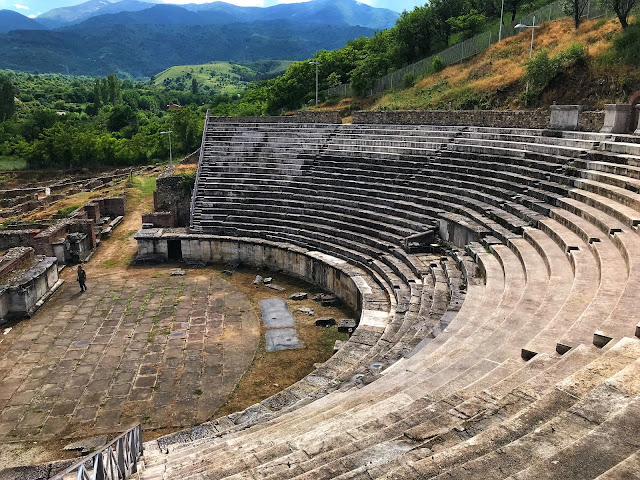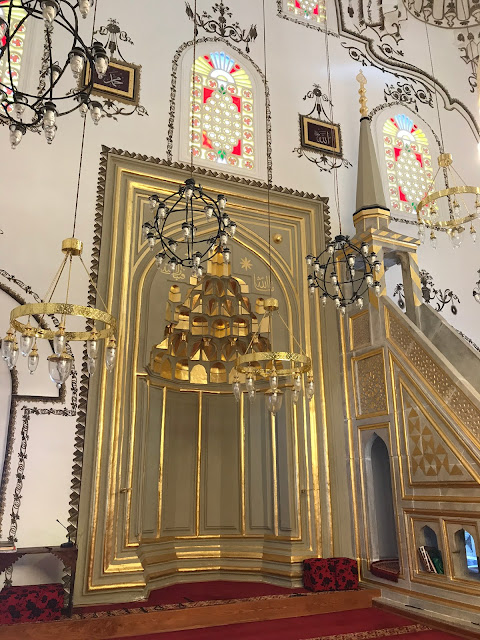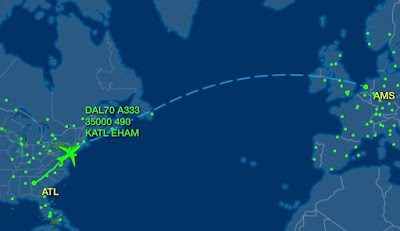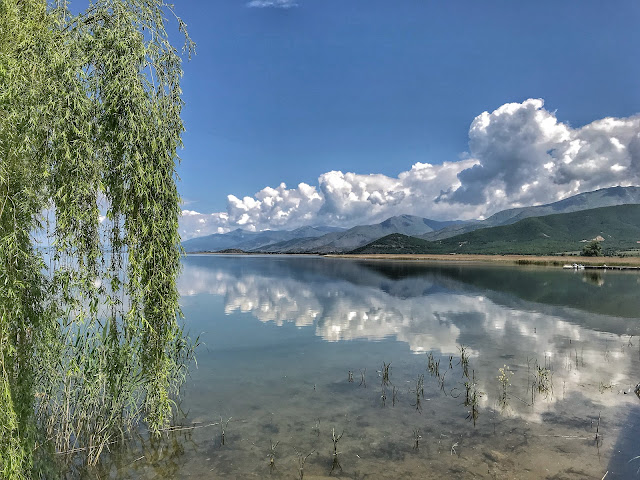It's Greek to Me
Balkans & Beyond, Days 48-49: Ohrid, Macedonia to Bitola, Macedonia. Departing Ohrid on Saturday, we couldn't resist the opportunity to drive along the eastern shore of the lake to National Park Galicica, which straddles Mount Galicica (7,395 ft) between Lakes Ohrid and Prespa. A well-maintained road takes visitors almost to the mountain's summit before descending down the other side to Lake Prespa. Along the scenic drive, views of the lake and towns along its coast are spectacular.
 |
| Lake Ohrid from scenic overlook in Galicica Park |
 |
| Old Roman theater at Heraclea Lyncestis |
 |
| Small basilica at Heraclea |
 |
| Širok Sokak Street |
 |
| Philip II reigns (and reins?) over Magnolia Square. |
 |
| Yeni Mosque |
 |
| Funeral notices |
Later our helpful innkeeper explained that these are death notices posted in the neighborhood where the deceased had lived. The wording is quite similar to what is published in newspaper obituaries in the U.S., including information about funeral arrangements.
 |
| Light up! No stigma here. |
Even though we had decided to leave Greece for another trip, being so close to the border and having seen all we planned to in Bitola on Saturday convinced us to consider a day trip into northern Greece on Sunday. With the ongoing dispute between Greece and Macedonia, we were a bit uncertain about what to expect at the border, so we did a little Googling—just enough to reveal a couple of nightmare tales about people being detained at the border by both Greek and Macedonian authorities for such infractions as calling a Greek city by its Macedonian name or carrying two cameras across the border.
 |
| Where are they now? |
 |
| The difference was evident at the border stations: Macedonia (top), Greece (bottom) |
 |
| E-65 in Greece |
 |
| On a secondary road to the lake shore |
With no specific destination in mind, we meandered through the town of Florina and aimed our GPS at the shores of Lake Prespa, hoping to find something scenic. As we approached the tiny village of Mikrolimni (pop. 72) on a narrow local road, we chanced upon an interesting Greek character, Mr. Santos, hobbling along the road with the aid of his cane.
He waved us down, and when we stopped, he asked us in Greek if we could give him a ride into town. We somehow understood what he needed and opened the door to the back seat. He climbed in and off we went. Later at a charming taverna on the lakeshore, we learned Mr. Santos' story from the restaurant owner's son-in-law.
He is currently 88 years old. During the Greek Civil War in the 1940s, Mr. Santos allied himself with the Communist partisans. While he was off in Yugoslavia for training, the Mikrolimni area was retaken by Greek government forces, making it unsafe for Mr. Santos to return to his village. Subsequently, he lived for many years in Czechoslovakia and then the Soviet Union before finally being allowed to return to his home town in the 1980s.
We enjoyed a lovely lunch of local dishes at the lakefront and wandered the area taking photos and enjoying the view before dragging ourselves away to return to Macedonia.
Tomorrow we'll drive to the Macedonian capital city, Skopje. From all we've read, it should be a highlight of the trip.
SATURDAY, 12 MAY & SUNDAY, 13 MAY, 2018
Two-Day Stats
• Started in: Ohrid, Macedonia
• Ended in: Bitola, Macedonia
• Miles driven: 186
• Miles walked: 12.23
• Weather: 49° to 73°, rain, sunny, partly cloudy
• Swallow nests: 87
• Curves in the road: 324
• Incredible views of the lake: 217
• Ashtrays in sidewalk cafes: 4,839
• Letterboxes planted: 2

Loved: The relief of four uneventful border crossings
Lacking: More time to spend in Greece. But we'll get back there soon.
Learned: As if we needed it, we were reminded again–when seeing the direct contrast between Macedonia and Greece–of the struggles former Communist countries are still enduring in an attempt to catch up with the progress made elsewhere while they were oppressed.
Lacking: More time to spend in Greece. But we'll get back there soon.
Learned: As if we needed it, we were reminded again–when seeing the direct contrast between Macedonia and Greece–of the struggles former Communist countries are still enduring in an attempt to catch up with the progress made elsewhere while they were oppressed.
More Photos
 |
| Swallows return to St. Naum on the lake because their mud nests attached to building eaves are tolerated at the monastery. |
 |
| Our drive up to the summit of Mount Galicica in Macedonia's National Park Galicica |
 |
| Remains of a courthouse at Heraclea |
 |
| Floor mosaics set two thousand years ago retain their detail and color. |
 |
| Greek scenery |
 |
| More Greek scenery |
 |













